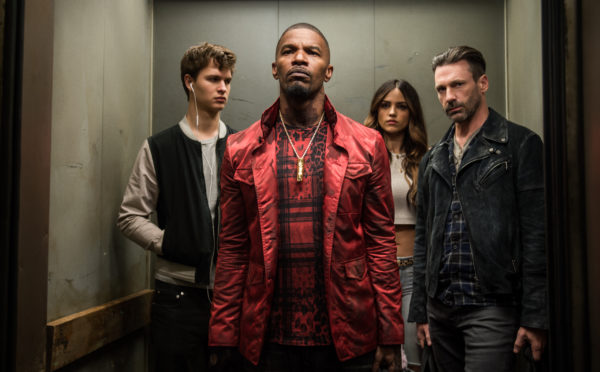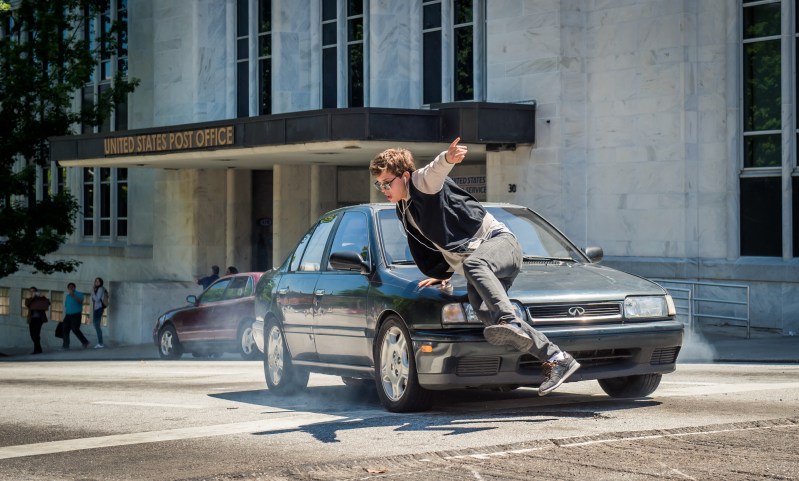I’m digging the recent resurrection of the film musical for postmodern times. Whit Stillman’s “Damsels in Distress” (2012) ended with a ludicrous dance combo across Stanford-like fountains of a preppy university, where sorority sisters and their thick-skulled Roman frat bros joined forces to spark the latest dance craze. (Do the Sambola!) Damien Chazelle’s “La La Land” showed how our minds are slowly degraded by mutt modern culture: whitewashing, the forgotten and eroded history of a city, an omnipresent fear of failure, money values trumping aesthetic and moral ones. These directors bring the musical back in a cheery, perverse manner: not as they once were, but as they can never be, and probably never were. Chazelle’s view is incredibly cynical; Stillman’s, more buoyant and chipper.
And what of Edgar Wright’s view? For him, Pop aesthetics are all we have; they will rule the day.
His “Baby Driver” is the latest entry in this Perverse 2010s Musical canon. This self-described “car chase musical” is full of surprises from minute one. It is choppy, unpredictable, bloody crazed. The kinetics of his previous comedies (“Shaun of the Dead,” “Hot Fuzz,” “Scott Pilgrim vs. the World”) haven’t quite prepared us for this sophisticated update on Jacques Demy’s “Lola” and the existential-road-movie. Rather than musing profoundly (“Two-Lane Blacktop”) or pining tragically (“Lola”), Wright’s mood is pretty optimistic—again, that modern perversity. The pop music of his childhood fills the air of “Baby Driver.” Wright has replaced the song-and-dance of a typical musical with sexy car chases and tender moments of lovers jamming out to T. Rex and Barry White through their Apple headphones. It’s a sharply felt movie that knows we live in the glorious (?) age of the Walking Musical. It explores how it feels to be stuck between two modes of living: lonely silence and bursts of emotional energy.
As in Wright’s best work, the film starts at Point A and will spend a half-hour before it lands at B . The opening car-chase, an indulgent interlude that works like an opening musical number, stems from the rich tradition of “Bullitt” and “The French Connection.” Constructively indulgent, it’s the type of spectacle you’d separate and watch on its own in hypnotic YouTube visits. There’s something sleekly erotic about it: Chiseled auto-bodies, the squeals of tires on hot pavement, the crew of saucy mixed-race criminals (Jon Hamm, Eiza González, peak Jamie Foxx) making their getaway.

At the wheel of these absurdly mint cars is Baby, the titular baby face, played by magnetic 23-year-old Ansel Elgort. Baby is a getaway driver in the vein of cinema’s Ryan Drivers (O’Neal in Walter Hill’s “The Driver” of 1978; Gosling in Refn’s “Drive” of 2011). But unlike his icey-distant cousins, Elgort’s Baby moves and mumbles with an infectious, warm, cute petulance. His edges seem to blur into the world he barely engages—rather than cleave himself from it, at sharp right-angles, in the mannered Ryan tradition. Elgort’s natural, uninflected stare (it’s all in the eyes) arouses the ire of his fellow bank robbers Foxx and Hamm. Elgort rejects their approach—hard-edged, cocked-eyebrow menace and scary facial hair—and, by being his own Millennial self, forges his own path: out of the getaway-driver game, and into the arms of a Shelly Johnson-like waitress (Lily James). Together, James’s and Elgort’s dreamy smiles are sketches of people who want to live life to its lovely fullest, but are too stupid to realize that such dreams are lies and myths today.
And yet—the music never stops in “Baby Driver.” It’s all anyone seems to be able to talk about. Baby and a postal worker both manage to bond over their love of Dolly Parton. What sets Jamie Foxx into fits of rage isn’t the success of a job, but the fact that this Millennial Brat won’t turn off his iPod for 5 minutes. And—even more so—that Baby is hella good at doing his job, while completely plugged in. The music has honed his skills. It has ironically connected him to the world around him and distanced him ever further. Maybe a connection is yet possible? But with whom? Lily James? And where? In the mind? In the la la land of the grey screen?
Wright understands why we need musicals. His “Baby Driver” uses pop music as a quasi-escapist release from a society that frowns on escapism. Fairly quickly, a state of disreality takes over the film. Its logic permits gun fights synced to the beats of The Champs’ absurd “Tequila,” with the cheeky brass toots underlining shots of mowed-down bad guys. Baby even restarts a song in the middle of a propulsive car-chase, because his movements weren’t synchronized to the music. To this barely-formed aesthete, the rhythm comes before everything else.
“Baby Driver” continues Edgar Wright’s love of smart surface. It’s rare that such a surface-oriented film feels so smashingly satisfying and intellectual. There’s barely time to stop and dwell on the images, which flick by with a zippy yet clear sense. Similar surface artists, like Demy and Vincente Minnelli, traffic in the same kinds of disparate emotions: an overload of surreal joy with shades of manic melancholia. They all see dancing and walking as inseperable—two modes of the same inexpressible emotions, ones that the cinema can best capture. In that vein, the best moment is when Ansel Elgort kicks a sheet of newspaper into the air to the beat of Commodores’s “Easy.” The move morphs into a dance figure, not fully formed, and is soon forgotten amid the shot-shot-shots. Here, Elgort and Wright discover the bridge between the all-dancing ideal of a movie musical and the real world. We must dance, it is natural, and, with a little help from our Spotify, we shall dance.
Contact Carlos Valladares at cvall96 ‘at’ stanford.edu.
